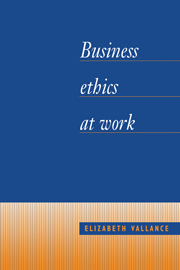3 - The ethical decision model
Published online by Cambridge University Press: 05 June 2012
Summary
Will not the knowledge of [the good], then, have a great influence on life? Shall we not, like archers who have a mark to aim at, be more likely to hit upon what is right?
(Aristotle, The Nicomachean Ethics)Before we can identify the principles and set the framework within which business ethics can proceed, we need to be clear not only about the nature of business but about the nature of ethics. We have already raised some of the arguments in general terms in chapter 1, about what business ethics is and is not and why we need it. This is worth reiterating now, along with the argument about the nature and aim of business (chapter 2), so that, putting these together with a more specific account of the nature of ethics itself, we may set the context within which an ethical decision model (EDM) can be developed. The EDM is not a formula, the terms of which can be substituted with numerical precision. As we shall see, it is rather a series of questions which aim to eliminate the irrelevant information, identify the ethical problem (if there is one) and suggest the principles on which an ethical solution may be based.
WHY BUSINESS ETHICS IS NECESSARY
Business ethics is, as I have said, not an enquiry into the foundations of ethics in general or into the justifications for competing moral philosophies. It takes for granted the existence of ethics, as it takes the existence of business as given. Furthermore, not all business decisions are ethical ones.
- Type
- Chapter
- Information
- Business Ethics at Work , pp. 42 - 52Publisher: Cambridge University PressPrint publication year: 1995



